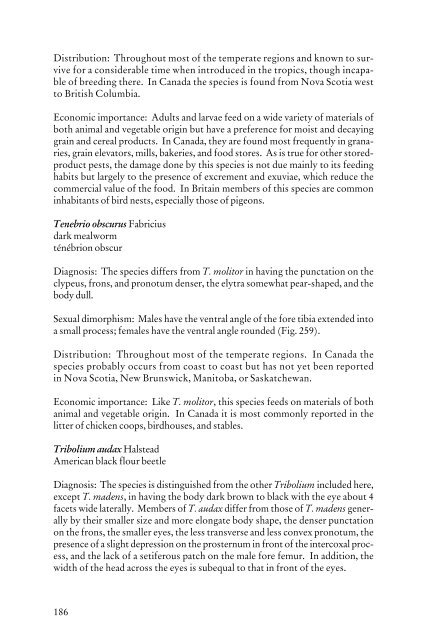Beetles Identification Guide
Beetles Identification Guide
Beetles Identification Guide
You also want an ePaper? Increase the reach of your titles
YUMPU automatically turns print PDFs into web optimized ePapers that Google loves.
Distribution: Throughout most of the temperate regions and known to survive<br />
for a considerable time when introduced in the tropics, though incapable<br />
of breeding there. In Canada the species is found from Nova Scotia west<br />
to British Columbia.<br />
Economic importance: Adults and larvae feed on a wide variety of materials of<br />
both animal and vegetable origin but have a preference for moist and decaying<br />
grain and cereal products. In Canada, they are found most frequently in granaries,<br />
grain elevators, mills, bakeries, and food stores. As is true for other storedproduct<br />
pests, the damage done by this species is not due mainly to its feeding<br />
habits but largely to the presence of excrement and exuviae, which reduce the<br />
commercial value of the food. In Britain members of this species are common<br />
inhabitants of bird nests, especially those of pigeons.<br />
Tenebrio obscurus Fabricius<br />
dark mealworm<br />
ténébrion obscur<br />
Diagnosis: The species differs from T. molitor in having the punctation on the<br />
clypeus, frons, and pronotum denser, the elytra somewhat pear-shaped, and the<br />
body dull.<br />
Sexual dimorphism: Males have the ventral angle of the fore tibia extended into<br />
a small process; females have the ventral angle rounded (Fig. 259).<br />
Distribution: Throughout most of the temperate regions. In Canada the<br />
species probably occurs from coast to coast but has not yet been reported<br />
in Nova Scotia, New Brunswick, Manitoba, or Saskatchewan.<br />
Economic importance: Like T. molitor, this species feeds on materials of both<br />
animal and vegetable origin. In Canada it is most commonly reported in the<br />
litter of chicken coops, birdhouses, and stables.<br />
Tribolium audax Halstead<br />
American black flour beetle<br />
Diagnosis: The species is distinguished from the other Tribolium included here,<br />
except T. madens, in having the body dark brown to black with the eye about 4<br />
facets wide laterally. Members of T. audax differ from those of T. madens generally<br />
by their smaller size and more elongate body shape, the denser punctation<br />
on the frons, the smaller eyes, the less transverse and less convex pronotum, the<br />
presence of a slight depression on the prosternum in front of the intercoxal process,<br />
and the lack of a setiferous patch on the male fore femur. In addition, the<br />
width of the head across the eyes is subequal to that in front of the eyes.<br />
186
















